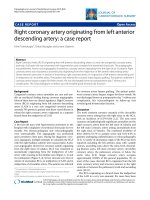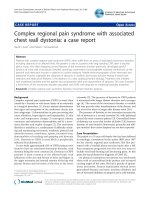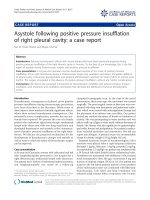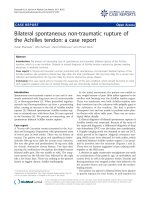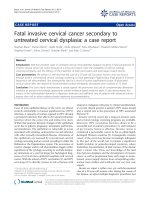Báo cáo y học: " Arthritis, osteomyelitis, septicemia and meningitis caused by Klebsiella in a low-birth-weight newborn: a case report" pps
Bạn đang xem bản rút gọn của tài liệu. Xem và tải ngay bản đầy đủ của tài liệu tại đây (1.36 MB, 4 trang )
CAS E REP O R T Open Access
Arthritis, osteomyelitis, septicemia and meningitis
caused by Klebsiella in a low-birth-weight
newborn: a case report
Ziaaedin Ghorashi
1
, Nariman Nezami
2*
, Hamideh Hoseinpour-feizi
1
, Sona Ghorashi
3
and Jafar Sadegh Tabrizi
4
Abstract
Introduction: Klebsiella pneumoniae is in most cases a hospital-acquired infection and presents as pneumonia,
septicemia and meningitis in patients with some predisposing factors, including prematurity, intravenous catheter,
history of antibiotic therapy and intravenous nutrients.
Case presentation: A low-birth-weight, 33-day-old Caucasian girl with respiratory distress syndrome was admitted
to our hospital. She developed septicemia, meningitis, polyarticular arthritis and osteomyelitis by nosocomial K.
pneumoniae which was resistant to most antibiotics except ciprofloxacin. She was therefore treated with
ciprofloxacin and co-trimoxazole for eight weeks. After completion of the treatment course, she completely
improved with excellent weight gain and without any adverse effects during three years of follow-up.
Conclusion: In the resistant strain of K. pneumoniae, ciprofloxacin could be considered as a therapeutic option
with the prospect of a good outcome, even in neonates and infants.
Introduction
Pneumonia is a type of infection that is most commonly
caused outside the hospital by Klebsiella pneumoni ae
[1]. Mostly, K. pneumoniae is recognized as a hospital-
acquired infection presenting as pneumonia, septicemia
and meningitis in patients with some predisposing fac-
tors (including prematurity, intravenous catheter, history
of antibiotic therapy and i ntravenous nutrients) [2,3]. In
the rare patients with underlying conditions among
newborns and older adults, K. pneumoniae may result in
arthritis and osteomyelitis. All Klebsiella subtypes are
resistant to ampicillin, especially multi-drug-resistant
(MDR) subtypes which are resistant to the majority of
antibiotics, except fourth-generati on cephalospo rins and
carbapenems. Previously, patients with MDR subtype
infections usually received first-generation cephalsporins
and aminoglycosides.
Case presentation
A 33-day-old Caucasian girl was brought to the Tabriz
Children’s Hospital with poor breastfeeding, recurrent
vomiting and anorexia. She was admitted with a primary
diagnosis of septicemia.
She was born from a mother with pre-eclampsia
through normal vaginal delivery at the 34th week of
gestation, with a birth weight of 1670 g. Her Apgar scores
at one and fiv e minutes were fiv e and six, respec tively.
During delivery and before admission to the Tabriz Chil-
dren’s Hospital, she had been hospitalized in the Talegani
neonatal intensive care unit for prematurity, septicemia,
respiratory distress syndrome and gastrointestinal bleed-
ing. In Talegani Hospital, she had received antibiotic
therapy, including ampicillin and gentamicin, then her
medication was changed t o cefotaxime and vancomycin,
and finally her t reatment continued with intravenous
immunoglobulin, imipenem and ceftazidime.
Her physical examination revealed that she was pale,
cachectic, anorexic and hypotonic, and her Moro and
sucking reflexes were weak. She also exhibited grunting
and had substernal and intercostal retraction. The
patient’ s body weight, height and head circumference
were 1700 g, 43 cm and 31 cm, respectively. Her vital
* Correspondence:
2
Drug Applied Research Center, Tabriz University (Medical Sciences), Tabriz,
Iran
Full list of author information is available at the end of the article
Ghorashi et al. Journal of Medical Case Reports 2011, 5:241
/>JOURNAL OF MEDICAL
CASE REPORTS
© 2011 Ghorashi et al; licensee BioM ed Central Ltd. This is an Open Access articl e distributed under the terms of the Creative
Commons Attribution License ( which permits u nrestricted use, distribution, and
reproduction in a ny medium, pr ovided the origina l work is properly cited.
signs, including pulse rate, respiratory rate, body tem-
perature, O
2
saturation under the oxygen hood and
without using the oxygen hood were 158/min, 48/min,
38.6°C, 95% and 89%, respectively.
Her cerebrospinal fluid (CSF) was purulent, and CSF
analysis showed 520 mg/dL protein; 16 mg/dL glucose;
many white blood cells (WBCs), with 85% polymorpho-
nuclear cells and 15% lymphocytes; and 25 red blood
cells (RBCs)/mm
3
. The results of the other laboratory
tests are shown in Table 1. In the CSF and blood cul-
ture, K. pneumonia was resistant to mo st of the antibio-
tics and sensitive only to ciprofloxacin and co-
trimoxazole. Her chest X-ray showed bilateral humeral
osteomyelitis and bilateral glenohumeral joint arthritis
(Figure 1).
On the basis of the paraclinical evidence, diag noses of
K. pneumoniae septicemia, meningitis, arthritis and
osteomyelitis were made, and a treatment protocol with
a combination of intravenous ciprofloxacin and co-tri-
moxazole antibiotics was started (for 28 days). At the
end of the intravenous treatment period, she weighed
2420 g, and her CSF analysis and culture were within
normal range. Afterward, she was discharged with oral
ciprof loxacin, co-trimoxazole and rifampicin for another
28-day period. F igures 2 and 3 show her chest X-rays
obtained on the seventh and 28th days of oral antibiotic
therapy, respectively. At the end of 28 days of oral anti-
biotic therapy (when the patient was 88 days old), her
weight had reached 4250 g and normal glenohumeral
joints and humerus bones were shown on her chest X-
ray. During three years of follow-up, she had normal
developmental milestones and was not readmitted to the
hospital.
Discussion
Prolonged hospital stay, decreased gestational age, pro-
longed use of broad-spectrum antibiotics and
inadequacy of some basic facilities and staffing carry the
risk of introduction of resistant hospital pathogens [4-6].
In the present case, all of the above-mentioned factors,
combined with prematurity, predisposed the neonate to
a higher risk o f contracting nosocomial K. pneumoniae
arthritis, osteomyelitis, septicemia and m eningitis,
although the common cause of oste oarthritis is Gram-
positive cocci [7].
Adeyemo et al. [8] reported an outbreak of bone
infections associated with neonatal septicemia by K.
pneumoniae in 12 neonates over a six month period at
the Special Care Baby Unit, University College Hospital,
Ibadan, Nigeria. All patients had septic arthritis, 10 of
them had osteomyelitis and 50% had multiple-joint
involvement.
Hospital-acquired K. pneumoniae has been reported to
be resistant to multiple antibiotics [8,9]. In addition,
Ghahramani and Nahaie [10] showed that K. pneumo-
niae is the most common cause of septicemia in the
neonatal ward of the Tabriz Al-Zahra Gynecology and
Obstetrics Referral Hospital in Tabriz, Iran.
The parenteral third-generation cephalosporins
appear to be a major therapeutic advance in the
Table 1 Laboratory tests and results on admission
a
Complete blood cell count Biochemical
analysis
Arterial blood gas
WBC count (cells/
μL)
6500 FBG (mg/
dL)
42 pH 7.29
Hb, g/Dl 7.8 Cr (mg/dL) 0.5 HCO
3
-
(mmol/
L)
20
Platelets, n/μL 773 ×
10
3
BUN (mg/
dL)
24 PCO
2
(mmHg) 43
PMN cells, % 51
Eosinophils, % 1% Electrolytes Other
Lymphocytes, % 24% Na (mEa/L) 136 CRP 2+
Monocytes, % 2% K (mEa/L) 45 Blood group A
+
Band cells, % 21% Ca (mg/dL) 10.8
a
WBC, white blood cells; Hb, hemoglobin; PMN, polymorphonuclear cells; CRP,
C-reactive protein; Na, sodium; K, potassium; BUN, blood urea nitrogen; FPG,
fasting plasma glucose; Ca, calcium.
Figure 1 Chest X-ray obtained at the time of admission.
Bilateral osteomyelitis in the humerus presented as osteolysis and
involucrum. Also, there is sequestration because of osteonecrosis
and a pathologic fracture in the proximal part of the humerus.
Dislocation of right glenohumeral joint brings up the arthritis
diagnosis. There is complete osteolysis in proximal metaphysis in
the left humerus and arthritis in the left glenohumeral joint. The
heart, lung and pleural space have a normal appearance, while the
thymus is atrophic.
Ghorashi et al. Journal of Medical Case Reports 2011, 5:241
/>Page 2 of 4
treatment of K. pneumoniae [11], but reports of highly
resistant strains that produce plasmid-mediated,
extended-spectrum b-lactamases influenced therapeutic
outcomes again [12]. Evidence revealed that K. pneumo-
niae infection, especially the nosocomial type, is resis-
tant to the majority of antibiotics except for
ciprofloxacin and ofloxacin [13]. In the present case
report, the isolated K. pneumoniae was resistant to most
of the antibiotics except ciprofloxacin and co-trimoxa-
zole. Therefore, these two a ntibiotics were used in the
treatment protocol. Because of the quinolone cartilage
toxicity potential in experimental juvenile animal mod-
els, the use of ciprofloxacin among children has been
restricted [13,14]. However, recent data from Bayer’ s
ciprofloxacin clinical trials database indicate that the
role of fluoroquinolones in the treatment of certain ser-
ious infections in children does not appear to be com-
promised by safety concerns when used appropriately
[15]. In such cases, when a micro-organism is resistant
to all antibiotics except ciprofloxacin, a dosage of 15
mg/kg/day to 30 mg/kg/day is advised in neonates [16].
After completion of the treatment course, our patient
comp letely improved and achieved normal developmen-
tal milestones and weight gain, without adverse effects
or hospital readmission during three years of follow-up.
Conclusion
In neonates with delivery problems, prematurity, low
birth weight and prolonged hospital admission, nosoco-
mial K. pneumoniae should be considered in the differ-
ential diagnosis of septicemia, arthritis, osteomyelitis
and meningitis. Considering the multi-drug resistance of
nosocomial K. pneumoniae and sensitivity to quinolones,
ciprofloxacin, when used appropriately, should be con-
sidered a therapeutic option with good outcomes in
patients with serious infections with resistant strains of
K. pneumoniae, even in neonates and infants.
Consent
Written informed consent was obtained from the patient’s
next-of-kin for publication of this case report and any
accompanying images. A copy of the written c onsent is
available for review by the Editor-in-Chief of this journal.
Abbreviations
CSF: cerebrospinal fluid; MDR: multi-drug-resistant.
Acknowledgements
The authors acknowledge the parents of the patient for their collaboration
and consent.
Author details
1
Department of Pediatrics, Tabriz University (Medical Sciences), Tabriz, Iran.
2
Drug Applied Research Center, Tabriz University (Medical Sciences), Tabriz,
Iran.
3
Young Researchers Club, Tabriz Branch, Islamic Azad University, Tabriz,
Figure 2 Chest X-ray obtained on the seventh day of oral anti-
biotic therapy. The lytic lesions in the proximal and distal
metaphysis in the right humerus are shown.
Figure 3 Chest X-ray showing complet e resolution of
symptoms at the end of anti-biotic therapy.
Ghorashi et al. Journal of Medical Case Reports 2011, 5:241
/>Page 3 of 4
Iran.
4
Faculty of Health and Nutrition, Tabriz University of Medical Sciences,
Tabriz, Iran.
Authors’ contributions
ZG, HH and SG collected the patient data and participated in the patient’s
hospitalization and treatment process. NN was a major contributor in writing
the manuscript. JST helped to revise and edit the manuscript. All authors
read and approved the final manuscript.
Competing interests
The authors declare that they have no competing interests.
Received: 1 February 2010 Accepted: 27 June 2011
Published: 27 June 2011
References
1. Donnenberg MS: Enterobacteriaceae. In Mandell, Douglas, and Bennett’s
Principles and Practice of Infectious Diseases. Volume II 6 edition. Edited by:
Mandell GL, Bennett JE, Dolin R. New York: Elsevier/Churchill Livingstone;
2005:2567-2586.
2. Feigin RD, Cherry J, Demmler-Harrison GJ, Kaplan SL: Feigin and Cherry’s
Textbook of Pediatric Infectious Diseases. 5 edition. Philadelphia: Saunders;
2004.
3. Asensio A, Oliver A, González-Diego P, Baquero F, Pérez-Díaz JC, Ros P,
Cobo J, Palacios M, Lasheras D, Cantón R: Outbreak of a multiresistant
Klebsiella pneumoniae strain in an intensive care unit: antibiotic use as
risk factor for colonization and infection. Clin Infect Dis 2000, 30:55-60.
4. Yalaz M, Arslanoğlu S, Çetin H, Aydemir Ş, Tünger A, Akısü M, Kültürsay N:
Evaluation of culture-proven sepsis in a level III NICU: a two year
analysis. Adnan Menderes Üniversitesi Tip Fakültesi Dergisi 2004, 5:5-9.
5. Turkish Neonatal Society; Nosocomial Infections Study Group: Nosocomial
infections in neonatal units in Turkey: epidemiology, problems, unit
policies and opinions of healthcare workers. Turk J Pediatr 2010, 52:50-57.
6. Cordero L, Rau R, Taylor D, Ayers LW: Enteric gram-negative bacilli
bloodstream infections: 17 years’ experience in a neonatal intensive care
unit. Am J Infect Control 2004, 32:189-195.
7. Nelson JD, Koontz WC: Septic arthritis in infants and children: a review of
117 cases. Pediatrics 1966, 38:966-971.
8. Adeyemo AA, Akindele JA, Omokhodion SI: Klebsiella septicemia,
osteomyelitis and septic arthritis in neonates in Ibadan, Nigeria. Ann
Trop Pediatr 1993, 13:285-289.
9. Westbrook GL, O’Hara CM, Roman SB, Miller JM: Incidence and
identification of Klebsiella planticola in clinical isolates with emphasis on
newborns. J Clin Microbiol 2000, 38:1495-1497.
10. Ghahramani P, Nahaie MR: Klebsiella sepsis in neonates admitted to Al-
Zahra Hospital, Tabriz. Med J Tabriz Univ Med Sci 2002, 35:69-73.
11. Tang LM, Chen ST, Hsu WC, Chen CM: Klebsiella meningitis in Taiwan: an
overview. Epidemiol Infect 1997, 119:135-142.
12. Smith CE, Tillman BS, Howell AW, Longfield RD, Jorgensen JH:
Failure of
ceftazidime-amikacin therapy for bacteremia and meningitis due to
Klebsiella pneumoniae producing an extended-spectrum β-lactamase.
Antimicrob Agents Chemother 1990, 34:1290-1293.
13. Akindele JA, Rotilu IO: Outbreak of neonatal Klebsiella septicemia: a
review of antimicrobial sensitivities. J Med Sci 1997, 26:51-53.
14. Ingham B, Brentnall DW, Dale EA, McFadzean JA: Arthropathy induced by
antibacterial fused N-alkyl-4-pyridone-3-carboxylic acids. Toxicol Lett 1977,
1:21-26.
15. Grady R: Safety profile of quinolone antibiotics in the pediatric
population. Pediatr Infect Dis J 2003, 22:1128-1132.
16. Nicholson JF, Pesce MA: Laboratory medicine, drug therapy and
reference tables. In Nelson Textbook of Pediatrics 17 edition. Edited by:
Behrman RE, Kliegman R, Jenson HB. Philadelphia: Saunders;
2004:2393-2505.
doi:10.1186/1752-1947-5-241
Cite this article as: Ghorashi et al.: Arthritis, osteomyelitis, septicemia
and meningitis caused by Klebsiella in a low-birth-weight newborn: a
case report. Journal of Medical Case Reports 2011 5:241.
Submit your next manuscript to BioMed Central
and take full advantage of:
• Convenient online submission
• Thorough peer review
• No space constraints or color figure charges
• Immediate publication on acceptance
• Inclusion in PubMed, CAS, Scopus and Google Scholar
• Research which is freely available for redistribution
Submit your manuscript at
www.biomedcentral.com/submit
Ghorashi et al. Journal of Medical Case Reports 2011, 5:241
/>Page 4 of 4



